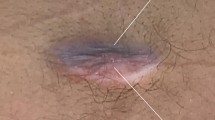Abstract.
Background: All split cord malformations (SCMs) arise from one basic fault, i.e. the formation of an accessory neurenteric canal between yolk sac and amnion through the midline embryonic disc that splits the notochord and neural plate. Multiple accessory neurenteric canals may lead to two or more noncontiguous SCMs, also known as composite SCM. Case histories: We present here three cases of composite SCM. First, a 2 1/2-year-old boy had type II SCMs at two different levels with normal cord between them. In case 2, a 16-month-old girl revealed a type I SCM at levels L2–3 and a type II SCM at level L5. The third case had a combination of both these types of SCMs at levels L1–3. Only very few cases of composite SCM have been reported in the literature. Conclusions: These three cases also support the unified theory proposed by Pang et al.
Similar content being viewed by others
Author information
Authors and Affiliations
Additional information
Electronic Publication
Rights and permissions
About this article
Cite this article
Vaishya, S., Kumarjain, P. Split cord malformation: three unusual cases of composite split cord malformation. Child’s Nerv Syst 17, 528–530 (2001). https://doi.org/10.1007/s003810100482
Received:
Published:
Issue Date:
DOI: https://doi.org/10.1007/s003810100482




